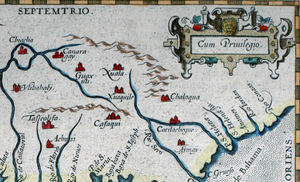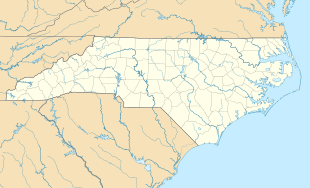| Fort San Juan | |
|---|---|
 A portion of a 1584 map by Geronimo Chaves depicting the site of "Xuala" where, in 1567, Juan Pardo established Fort San Juan. | |
| Location | Morganton, North Carolina |
| Coordinates | 35°49′27″N 81°44′1″W / 35.82417°N 81.73361°W |
| Built | 1567 |
| Demolished | 1568 |
| Owner | Privately owned |
Fort San Juan was a late 16th-century fort built by the Spanish under the command of conquistador Juan Pardo in the native village of Joara, in what is now Burke County, North Carolina.[1][2] Used as an outpost for Pardo's expedition into the interior of what was known to the Spaniards as "la Florida", Fort San Juan was the foremost of six forts built and garrisoned by Pardo in modern-day North Carolina, South Carolina, and Tennessee to extend Spain's effective control deeper into the North American continent.
Fort San Juan was the first European settlement in North Carolina and the interior of present-day United States, predating the earliest English settlement at Roanoke Island, North Carolina by 18 years.[3] In 1568, natives from Joara and the region surrounding the fort razed this and the five other Spanish forts, killing all but one of the soldiers.[4][5]
After the fort's destruction, its exact location was lost. Archaeological work has been underway for years, revealing artifacts suggestive of Spanish settlement. During the summer of 2013, archaeologists affiliated with the University of Michigan, Tulane University and Warren Wilson College announced that they had discovered evidence of a defensive moat and other remains, definitive evidence of Fort San Juan.[5][6]
- ^ Charles Hudson (28 July 2005). The Juan Pardo Expeditions: Exploration of the Carolinas and Tennessee, 1566-1568. University of Alabama Press. ISBN 978-0-8173-5190-8.
- ^ Glanville, Jim (2009). "16th Century Spanish Invasions of Southwest Virginia" (PDF). Historical Society of Western Virginia Journal. 18 (1): 34–42. Retrieved 2013-12-27.
- ^ Beck, Robin A. Jr.; Moore, David G.; Rodning, Christopher B. (2006). "Identifying Fort San Juan: A Sixteenth-Century Spanish Occupation at the Berry Site, North Carolina" (PDF). Southeastern Archaeology. 25 (1): 65–77. Retrieved 2013-12-27.
- ^ "Marker: N–47 – FORT SAN JUAN". North Carolina Highway Historical Marker Program. North Carolina Department of Cultural Resources. Retrieved August 17, 2013.
- ^ a b John Noble Wilford (July 23, 2013). "Fort Tells of Spain's Early Ambitions". The New York Times. Retrieved August 17, 2013.
- ^ Archeology: "Berry Site" Archived 2014-08-18 at the Wayback Machine, Warren Wilson College


